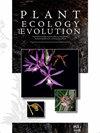巴西埃斯帕纳帕拉多山脉一种蓝叶山菖蒲新种(槟榔科)
IF 1.1
4区 生物学
Q3 PLANT SCIENCES
引用次数: 2
摘要
背景和目的-本研究是正在进行的Serra do Cabral山槟榔科植物区系研究的一部分,Serra do Cabral是米纳斯吉拉斯州espinhaarso山脉西南部的一个孤立的山体。由于地块的隔离,该地区具有丰富的生物多样性和高度的地方性。在寻找稀有和极度濒危的Syagrus cabraliensis种群时,发现了一种新的蓝叶棕榈物种,并在这里进行了描述。材料和方法-根据野外采集的资料描述了新种的形态。耳廓采用扫描电镜和LM横剖面和纵剖面,按照默认的方法进行分析。此外,我们还将其与S. cabraliensis进行了比较,并给出了生态笔记和保护现状评价。主要结果-卡瓦霍象与卡布兰象相似,但它们可以很容易地通过形态解剖特征加以区分。这两个物种在Serra do Cabral中不对称地出现,在不同的微生境中:S. carvalhoi在南石英campos rupestres中,S. cabraliensis在北铁质campos rupestres中。提供了从地块中已知的草状Syagrus物种的关键。基于限制发生区域和人为威胁,将其评定为极度濒危物种。结论:Syagrus carvalhoi是Serra do Cabral的第二个草状地方性Syagrus物种,在属中具有罕见的特征(草状外貌,殖民地习性,四分体花,茎在地面或地下分叉)。这一发现证实了这一孤立的OCBIL是地方性和稀有棕榈物种的家园。Serra do Cabral块体已被证明是槟榔科植物形态和解剖学上的新来源,影响了棕榈的分类和进化与生态的理解。我们的研究结果强化了这样一种观念,即保护这一拥有丰富而稀有生物多样性的地区是非常重要的,但它正面临着令人担忧的前所未有的威胁。本文章由计算机程序翻译,如有差异,请以英文原文为准。
A new bluish-leaved Syagrus (Arecaceae) from an overlooked OCBIL in the Espinhaço Range (Brazil)
Background and aims – This study is part of ongoing research on the Arecaceae Flora of the Serra do Cabral, an isolated massif in the southwest of the Espinhaço Range in Minas Gerais State. Because of the isolation of the massif, the area has a rich biodiversity and a high level of endemism. While searching for populations of the rare and critically endangered Syagrus cabraliensis, a new bluish-leaved palm species was discovered and it is described here.
Material and methods – The new species’ morphology is described based on field collections. The pinnae were analysed using SEM and LM cross- and longitudinal sections following default methodology. In addition, we compared the species to S. cabraliensis and provided ecological notes and a conservation status assessment.
Key results – Syagrus carvalhoi resembles S. cabraliensis but they can easily be distinguished by morphoanatomical characters. Both species occur non-sympatrically in the Serra do Cabral, in contrasting microhabitats: S. carvalhoi in the southern quartzitic campos rupestres and S. cabraliensis in the northern ferruginous campos rupestres. A key to the known grass-like Syagrus species from the massif is provided. Based on the restricted area of occurrence and the anthropogenic threats, Syagrus carvalhoi is assessed as critically endangered.
Conclusion – Syagrus carvalhoi is the second grass-like endemic Syagrus species from the Serra do Cabral and presents rare characters within the genus (grass-like aspect, colonial habit, flowers in tetrads, and the stem forking at or below the ground). This discovery corroborates that this isolated OCBIL is a home for endemic and rare palm species. The Serra do Cabral massif has proved a source of morphological and anatomical novelties in Arecaceae, affecting the taxonomy and understanding of the evolution and ecology of palms. Our results reinforce the notion that it is important to conserve this area with rich and rare biodiversity but under alarming and unprecedented threats.
求助全文
通过发布文献求助,成功后即可免费获取论文全文。
去求助
来源期刊

Plant Ecology and Evolution
PLANT SCIENCES-
CiteScore
2.20
自引率
9.10%
发文量
27
审稿时长
>12 weeks
期刊介绍:
Plant Ecology and Evolution is an international peer-reviewed journal devoted to ecology, phylogenetics and systematics of all ‘plant’ groups in the traditional sense (including algae, cyanobacteria, fungi, myxomycetes), also covering related fields.
The journal is published by Meise Botanic Garden and the Royal Botanical Society of Belgium.
 求助内容:
求助内容: 应助结果提醒方式:
应助结果提醒方式:


